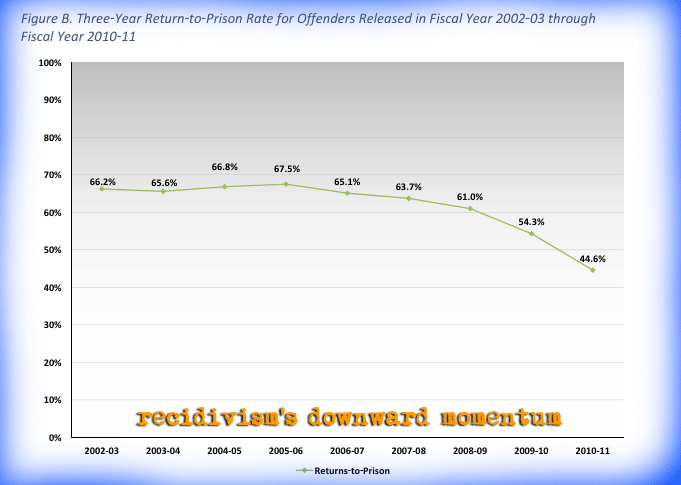CDCR REPORT SHOWS BIG DROP IN RE-INCARCERATION RATES FOR STATE PRISONERS IN 2015
Three-year recidivism rates for California’s prisoners has dropped significantly for the fifth consecutive year, according to new data from the California Department of Corrections and Rehabilitation (CDCR).
The 87-page report revealed a 10% recidivism reduction—from 54.3% in 2014 to 44.6%—for inmates released during the 2010-2011 fiscal year compared with those released during fiscal year 2009-2010. Even lower than the statewide recidivism rate, was the rate for Los Angeles County: 32.3%.
Of the offenders who received substance abuse treatment both behind bars and post-release, just 15.3% returned to prison during that three year period following their release.
“Most offenders sent to prison are eventually released, and so rehabilitation is in everyone’s best interest—our staff, the inmates and the community at large,” said CDCR Secretary Scott Kernan. “The latest recidivism rate shows that we’re helping more inmates learn how to live a law-abiding, productive life.”
BILL TO ENSURE JAIL INMATES HAVE ACCESS TO IN-PERSON VISITS AWAITS SIGNATURE FROM GOVERNOR
As some jails gradually increase the use of video visitation and decrease in-person visits for inmates and their loved ones, a California bill aims to protect those face-to-face visits. The bill, authored by CA Senator Holly Mitchell (D-Los Angeles), which would require counties to provide in-person visitation in jails by 2022, has made it to Governor Jerry Brown’s desk for final approval.
“Every year California releases thousands of jail inmates whose chances of staying out and straightening up rise in proportion to how closely they stayed in touch with family members while in jail,” said Mitchell, explaining the importance of keeping inmates and their families connected.
DOJ TRAINING VIDEO SHOWS LAW ENFORCEMENT HOW TO TREAT TRANSGENDER PEOPLE DURING TRAFFIC STOPS AND OTHER ENCOUNTERS
The US Department of Justice has released a video (above) for the nation’s law enforcement officers explaining transgender terminology and how to have respectful, kind interactions with transgender people with whom they come into contact.


No mention of why the return rate is lower? Could it be cops are putting their blinders on? Could it be that dope is not a crime a cop cares about anymore cause of the reclassification that was in and of itself criminal? This article really makes it sound like things are actually better. Will there EVER be any unbiased reporting ever again??
Clearly the top two reasons for lower recidivism rates are:
-MANY felonies have been reduced to misdemeanors
-Convicted “non-violent” felons are being housed in county jails now.
Poof, magic! Less state prisoners. Amazing!
Ever seen an ADW conviction that qualifies as non-violent under AB109? I’ve seen several, and they’re sentenced to lengthy JAIL time. Yup, several-year stretches in county jail.
Ownership is correct. The report refers to the rate prisoners return to the state’s PRISON system, NOT the various county JAIL systems. For those who don’t know the difference, its significant. When Proposition 47 was passed, many crimes were declassified from felonies to misdemeanors. This was not an effort to “help” criminals. Why in God’s green earth would we want to do that? Why not help the thousands upon thousands of victims instead? This was all about “how can we get them out of the expensive state prison system so that we don’t have to pay for them with sate money.” You CANNOT be sentenced to state prison for MISDEMEANOR convictions. However, you can be sent to county jail for extended periods. In addition, you can also be convicted of a felony and, instead of being sent to prison, you can be sent to serve your time in a county jail. So, when this happens (it happens ALL the time), reports such as the one put out about the state’s recidivism rate are grossly inaccurate and paint the wrong picture (well, its paints the picture based on the agenda). Sure, fewer prisoners are returning to state prison, but part two to that paradigm is not addressed: (1) Are former convicted felons still committing crime and (2) are former state prisoners being incarcerated within the state’s county jail systems? Here is an interesting question, if the recidivism rate is down, then why is the crime rate up? So, even if convicted criminals are not in the prison system, but are now in the county systems, who now pays for their incarceration? YOU STILL DO! YOU PAY FOR IT THROUGH YOUR RESPECTIVE COUNTY TAXES along with a subsidy from the state. So, those who came up with the idea of proposition 47 will never ask “where did all the prisoners go?”. It goes to the old saying; “Be careful what you ask for.” So, they are being careful. They are reporting the factual information that the state prison recidivism rate is down a whopping 10% (hardly anything worth patting yourself on the back for to begin with). However, the research falls short by failing to answer part two; what then is becoming of these former prisoners? I would bet my life that FEWER than 10% of the state’s prisoner population are seeing the proverbial light and are now productive members of society. I am not willing to risk my family’s safety based on this sort of irrational thinking. I am convinced that a subset of our society refuses to follow the rules and, therefore, needs to be removed from society. Yes, its expensive. I Am willing to pay taxes in order to keep them locked up so that my children can play up and down the street and in the parks. So that I don’t have to worry about someone breaking into my house to take what I worked so hard for. So that someone’s innocent life isn’t taken. When its YOUR child, you cannot put a price on that, but certainly, the price to house criminals pales in comparison.